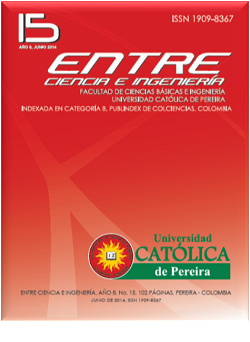Analytical and quantitative determination of antioxidants in tomato chonto typical vegetable from Quindío
Keywords:
electrochemica, pectrum photometry, Uv-visible,, tomato, vitaminAbstract
This article describes the process in which tomato chontowas gathered in the postharvest stage in Filandia Quindío town,and physicochemical characterization was carried out: potential ofhydrogen (pH), soluble solids (° Brix), water activity (aw), color, acidity.UV-Visible spectrophotometry technique to quantify vitamin C wasused. It was compared with electrochemical methods. According topreliminary information the conclusions were: a) the aw is very close tothe theoretical value; therefore, is possible to establish that this tomatohas a juicy texture, tender and chewy b) °Brix obtained indicate thatchonto tomato has a high nutritive value c) Potential hydrogen indicatesthe high acidity of the tomato subsequently demonstrated with thetitratable acidity values. d) Color results also showed a nutrient richand healthy tomato e) spectrophotometric analysis allowed to know theconcentrations of vitamin C in tomatoes.
References
David J. Williams, David Edwards, Sharon Pun, Mridusmita Chaliha, Yasmina Sultanbawa. Profiling ellagic acid content: The importance of form and ascorbic acid levels. Food Research International, Volume 66, pp. 100-106, 2014.
Remini, C. M, Amine B., Nawel A., Manuel D., Khodir M. Degradation kinetic modelling of ascorbic acid and colour intensity in pasteurised blood orange juice during storage. Hocine. Food Chemistry, In Press, Accepted Manuscript, Available online 23 October 2014.
Cardona E, Ríos L, and Restrepo G. Extracción Del Carotenoide Licopeno Del Tomate Chonto (Lycopersicum Esculentum). Vitae, Revista de La Facultad De Química Farmacéutica. Volumen 13 número 2, pp. 44-53, 2006.
Meng N, Gary G. Hou, Xiaodan Li, Li Wang, Zhengxing Chen. Inhibitory effects of ultrasound combined with ascorbic acid or glutathione on enzymatic darkening of whole-wheat raw noodles. LWT Food Science and Technology, Volume 59, Issue 2, Part 1, pp. 901-907, 2014.
A. Nath, S. Mandal, R.K. Singh, Bidyut C. Deka, S.V. Ngachan. Chapter 4 – Ascorbic Acid, β-Carotene and Antioxidant Activity of Broccoli During Short-Term Refrigerated Storage. Processing and Impact on Active Components in Food, pp. 27-34, 2015.
T. Young, T., Juvik, J and Sullivan, J. Accumulation of the components of total solids in ripening fruits of tomato. Journal of the American Society for Horticultural Science Vol. 118. Pp. 286-292. 1993.
J. Bezert, Sistema de pago por calidad de tomate. Universidad Católica de Valparaíso. Facultad de Agronomía. Curso Internacional de Tomate Industrial. Viña del Mar. 1-3 diciembre. pp. 7-10, 1994.
M. Brewer, G. Rodriguez, M.J. Gonzalo, C. Anderson, L. Lang, D. Sullivan, N. Dujmovic, K. Fujimuro, S. Gray and E. Van Der Knaap. “Tomato Analyzer User Manual” Versión 2.2.0.0. Consultado el 25 de abril del 2010.
Sarubin F., Thomson C. “The Health Professional’s Guide to Popular Dietary Supplements”. 3rd ed. Chicago, Il: American Dietetic Association; 2007
Institute of Medicine. Food and Nutrition Board. “Dietary Reference Intakes for Vitamin C, Vitamin E, Selenium, and Carotenoids”. National Academy Press, Washington, DC, 2000.
F. Artés-Calero, F. Artés-Hernández. “Tratamientos postrecolección del tomate fresco”. Tendencias e innovaciones, Capítulo 10, pp. 109- 120. In: Tomates, Producción y comercio. Ediciones de Horticultura S.L. Reus, España. ISBN 84-87729-48-7 2004.
Gómez A., Ceballos N., Orozco F and Parra C. Efecto Del Sistema De Producción En Semitecho Sobre El Desarrollo, Rendimiento Y Calidad Del Tomate (Solanum Lycopersicum L.). Agron. Vol. 18 (2), pp. 47 - 57, 2010.
Barros, L., Falcão, S., Baptista, P., Freire, C., Vilas-Boas, M., and Ferreira, I. C. F. R. “Antioxidant activity of Agaricus sp. Mushrooms by chemical, biochemical and electrochemical assays”. Food Chemistry, Vol. 111, pp. 61–66, 2008
Leubolt, R., Klein,H. “Determination of sulphite and ascorbic acid by high-performance liquid chromatography with electrochemical detection”, J. Chromatography. Vol. 640. pp. 271–277, 1993.
Euroresidentes, “Alimentos-Vitamia E”, sitio en internet, encontrado Noviembre 20 del 2012. Disponible: http://www.euroresidentes.com/ Alimentos/vitaminas/vitamina-e.htm
Georgios T., Costas D., Nikolaos N., Panagiotis K., Georgios A. Low temperature storage affects the ascorbic acid metabolism of cherry tomato fruits. Plant Physiology and Biochemistry, Vol. 84, pp. 149- 157, 2014.








 Revista Entre Ciencia e Ingeniería
Revista Entre Ciencia e Ingeniería .png) entrecei@ucp.edu.co
entrecei@ucp.edu.co.png) ISSN (Impreso) 1909-8367 - ISSN (En Línea) 2539-4169
ISSN (Impreso) 1909-8367 - ISSN (En Línea) 2539-4169 Attribution-NonCommercial 4.0 International (CC By-NC 4.0)
Attribution-NonCommercial 4.0 International (CC By-NC 4.0)
.png) Carrera 21 No. 49-95 Av. de las Américas, Pereira, Risaralda, Colombia
Carrera 21 No. 49-95 Av. de las Américas, Pereira, Risaralda, Colombia